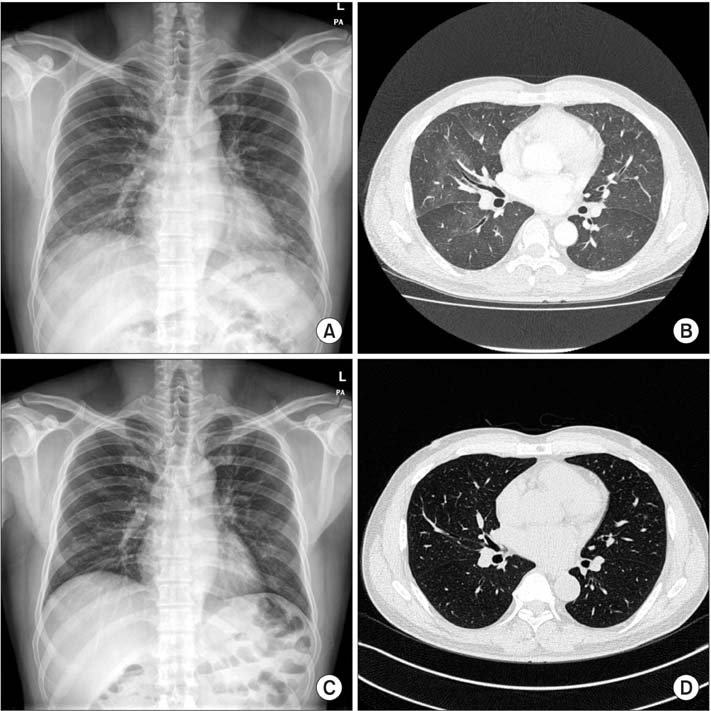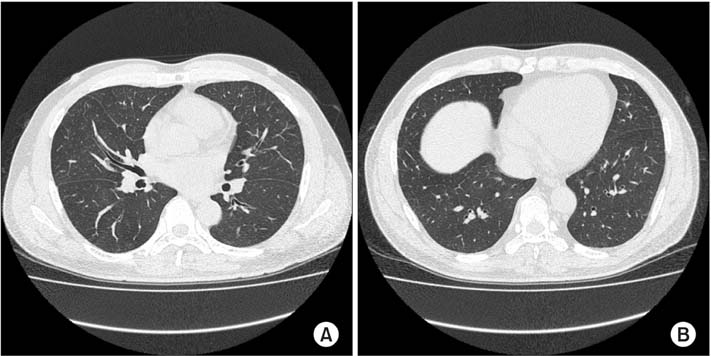Tuberc Respir Dis.
2015 Oct;78(4):375-379. 10.4046/trd.2015.78.4.375.
A 45-Year-Old Man With Recurrent Dyspnea and Hemoptysis during Exercise: Exercise-Induced Pulmonary Hemorrhage/Edema
- Affiliations
-
- 1Division of Respiratory and Critical Care Medicine, Department of Internal Medicine, Konyang University Hospital, Daejeon, Korea. sjoongkwon@hanmail.net
- KMID: 2320710
- DOI: http://doi.org/10.4046/trd.2015.78.4.375
Abstract
- A 45-year-old man presented with dyspnea and hemoptysis during exercise. A chest computed tomography (CT) revealed multifocal diffuse patchy ground glass opacity and interlobular septal thickening in both the lungs. Permeability pulmonary edema or pulmonary hemorrhage was suspected. Serologic studies for autoimmune disorders and vasculitis were negative. There was no laboratory evidence of coagulopathy, other hematopoietic disease or infectious disease. Considering correlation with exercise, we diagnosed exercise-induced pulmonary hemorrhage (EIPH) or exercise-induced pulmonary edema (EIPE). The patient was managed with antifibrinolytics, antibiotics, and antitussive agent. After a week, follow-up chest CT revealed completely resolved pulmonary hemorrhage. About 2 months after the first event, he visited again with dyspnea and hemoptysis during running. In the present study, we report a case of recurrent pulmonary hemorrhage after exercise.
Keyword
MeSH Terms
Figure
Reference
-
1. Ghio AJ, Ghio C, Bassett M. Exercise-induced pulmonary hemorrhage after running a marathon. Lung. 2006; 184:331–333.2. McKechnie JK, Leary WP, Noakes TD, Kallmeyer JC, MacSearraigh ET, Olivier LR. Acute pulmonary oedema in two athletes during a 90-km running race. S Afr Med J. 1979; 56:261–265.3. Luks AM, Robertson HT, Swenson ER. An ultracyclist with pulmonary edema during the Bicycle Race Across America. Med Sci Sports Exerc. 2007; 39:8–12.4. Lund KL, Mahon RT, Tanen DA, Bakhda S. Swimming-induced pulmonary edema. Ann Emerg Med. 2003; 41:251–256.5. West JB, Mathieu-Costello O, Jones JH, Birks EK, Logemann RB, Pascoe JR, et al. Stress failure of pulmonary capillaries in racehorses with exercise-induced pulmonary hemorrhage. J Appl Physiol (1985). 1993; 75:1097–1109.6. Kindig CA, McDonough P, Fenton G, Poole DC, Erickson HH. Efficacy of nasal strip and furosemide in mitigating EIPH in Thoroughbred horses. J Appl Physiol (1985). 2001; 91:1396–1400.7. Williams KJ, Robinson NE, Defeijter-Rupp H, Millerick-May M, Stack A, Hauptman J, et al. Distribution of venous remodeling in exercise-induced pulmonary hemorrhage of horses follows reported blood flow distribution in the equine lung. J Appl Physiol (1985). 2013; 114:869–878.8. Sinha AK, Gleed RD, Hakim TS, Dobson A, Shannon KJ. Pulmonary capillary pressure during exercise in horses. J Appl Physiol (1985). 1996; 80:1792–1798.9. Williams KJ, Derksen FJ, de Feijter-Rupp H, Pannirselvam RR, Steel CM, Robinson NE. Regional pulmonary veno-occlusion: a newly identified lesion of equine exercise-induced pulmonary hemorrhage. Vet Pathol. 2008; 45:316–326.10. Derksen F, Williams K, Stack A. Exercise-induced pulmonary hemorrhage in horses: the role of pulmonary veins. Compend Contin Educ Vet. 2011; 33:E6.11. Hull JH, Menzies-Gow A, Nicholson AG, Mohiaddin RH, Maher TM. Exercise-induced haemoptysis: a thoroughbred cause? Thorax. 2013; 68:599–600.12. West JB. Invited review: pulmonary capillary stress failure. J Appl Physiol (1985). 2000; 89:2483–2489.13. Hinchcliff KW. Exercise-induced pulmonary hemorrhage. In : Pagan JD, editor. Advanced in equine nutrition. Nottingham: Nottingham University Press;2009. Vol. IV:p. 367–377.14. Manohar M, Hutchens E, Coney E. Frusemide attenuates the exercise-induced rise in pulmonary capillary blood pressure in horses. Equine Vet J. 1994; 26:51–54.15. Epp TS, McDonough P, Padilla DJ, Gentile JM, Edwards KL, Erickson HH, et al. Exercise-induced pulmonary haemorrhage during submaximal exercise. Equine Vet J Suppl. 2006; (36):502–507.
- Full Text Links
- Actions
-
Cited
- CITED
-
- Close
- Share
- Similar articles
-
- Wheat-dependent, Exercise-induced Anaphylaxis: A Successful Case of Prevention with Ketotifen
- Exercise-Induced Intrapulmonary Arteriovenous Shunt in a Patient Complaining of Dyspnea during Strenuous Exercise
- A case of exercise-induced anaphylaxis in an asthmatic patient
- The Study on the Effects of a Respiratory Rehabilitation Program for COPD Patients
- Change of Pulmonary Function after Exercise Loading Test and Preventive Measures on Exercise-induced Asthma in Chlidren




